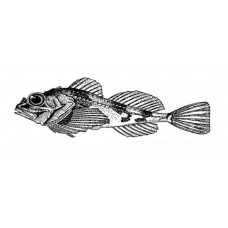Latin name
Micrenophrys lilljeborgii
Other name
Micrenophrys lilljeborgii
Identification
The skin of the Norway bullhead is smooth, without scales. It is similar in appearance to the Longspined Bullhead. The shape of the head and body is somewhat similar to Icelus bicornis. The interorbital space is concave, its edges are slightly raised, the occiput is not depressed. The bones of the head are covered with skin, bony granulation is not developed on them. The occiput has 2 short ridges formed by 2 pairs of blunt tubercles. The diameter of the eyes is equal to the length of the snout. Preoperculum with 4 barbs, the uppermost barb long and developed, equal in length to the diameter of the eye rather than exceeding it. Corners of mouth with a single small tendrils. Gill membranes attached to the pharynx, not forming folds. The lateral line is covered with bony plates, above the lateral line the body is covered with spines, which are also present on the posterior part of the body. There is no swim bladder.
Features of fish fins
There are only two rays in the pelvic fin of these fish. The pectoral fins are fan-shaped. The pelvic fins have one barbed and 2 soft rays.
Fish colouring
Coloration varies depending on habitat - usually greenish brown or tan to yellowish with 4 dark gray irregular transverse stripes on body, underside of body yellowish. Males have a red band behind the head and red spots on the flanks.
Distribution
This species is distributed in the Northeast Atlantic from central Norway to western Iceland, south to the British Isles, Skagerrak, northern North Sea.
Habitat
A benthic marine species that prefers brackish waters and temperate climates. Its depth range is from 0 to 100 meters. It lives on hard bottoms (gravel or shells) or among algae at temperatures below 0°C. It is known to be found at reduced salinity (28.5‰).
Size
Fish of this species are up to 7.4 cm long, but usually no more than 5-5.5 cm.
Behavior
Behaviour is poorly studied. It inhabits rocky substrates in algal thickets. In the south of the range it is usually found at depths of 20-90 m, but also in shallow waters, beyond the intertidal zone, often in puddles on the shore with algal thickets.
Food and feeding habits
Norway bullheads feed on small bottom-dwelling animals.
Reproduction
Spawns in spring. Females lay eggs in clutches on the bottom, probably guarded by the male. Larvae live in the pelagial. At a length of 1-1.4 cm they switch to benthic life.
Fishing
This species is not commercially important.
Relationship with a person
Harmless.
| Classification | |
| Phylum | Chordata |
| Class | Actinopterygii |
| Squad | Perciformes |
| Family | Psychrolutidae |
| Genus | Micrenophrys |
| Species | M. lilljeborgii |
| Features | |
| Conservation status | Least Concern |
| Habitat | Bottom |
| Life span, years | No information |
| Maximum body weight, kg | No information |
| Maximum length, cm | 7,4 |
| Sailing speed, m/s | No information |
| Threat to people | Edible |
| Way of eating | Bentophage |
Norway bullhead
Tags: norway bullhead

